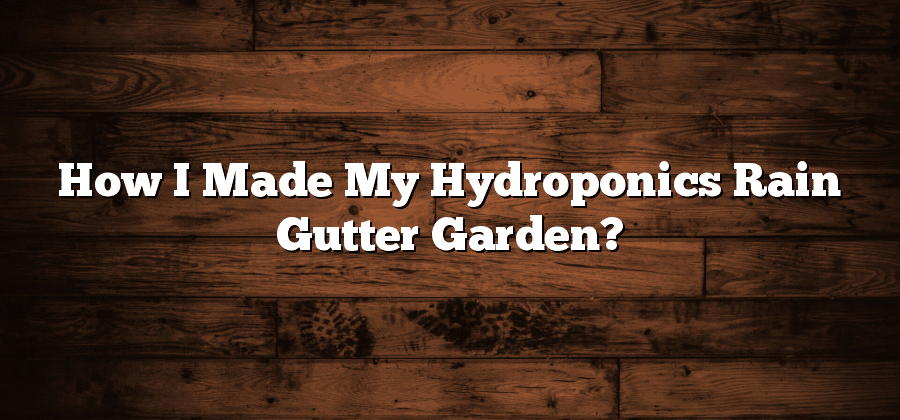Choosing the Ideal Location for Your Hydroponics Garden
Hydroponics gardening is a highly efficient and innovative way to grow plants without soil. This method of gardening utilizes water infused with essential nutrients to nourish the plants, resulting in faster growth and higher yields. However, in order to achieve optimal results, it is crucial to choose the right location for your hydroponics garden.
The first step in selecting the ideal location for your hydroponics garden is to consider the amount of sunlight that the area receives. **Sunlight** is essential for photosynthesis, the process by which plants convert light energy into food. Therefore, it is important to choose a spot that receives at least six hours of direct sunlight each day. Additionally, keep in mind that different plants have varying sunlight requirements, so it is important to research the specific needs of the plants you intend to grow.
Another factor to consider when choosing the location for your hydroponics garden is **accessibility to water**. Since hydroponics gardening relies on a water-based system, it is important to have a nearby water source for your plants. This can be in the form of a water faucet, hose, or even a rainwater collection system. Easy access to water will make it more convenient to maintain and monitor the nutrient levels in your hydroponics system.
As you plan the location for your hydroponics garden, it is important to consider both the sunlight requirements of your plants and the accessibility to a water source. By carefully selecting the ideal location, you will be on your way to creating a successful hydroponics garden that can produce bountiful harvests year-round.
Understanding the Basics of Hydroponics and Rain Gutter Systems
Hydroponics, the art of growing plants without soil, has gained popularity among gardening enthusiasts in recent years. This method involves providing all the necessary nutrients directly to the plants’ roots, ensuring optimal growth and health. One innovative approach to hydroponics is the use of rain gutter systems as a growing medium. Rain gutters, typically used for collecting and redirecting rainwater, can be repurposed to create an efficient and space-saving hydroponics garden.
The concept behind rain gutter systems in hydroponics is simple yet effective. The gutters are positioned horizontally, allowing the nutrient-rich water to flow from one end to the other, bathing the plants’ roots as it passes through. This technique maximizes the use of vertical space, making it ideal for small yards or even urban gardening. Furthermore, rain gutter systems offer excellent drainage capabilities, preventing waterlogging that can be detrimental to plants. With the right materials and proper construction, a rain gutter hydroponics garden can be a productive and aesthetically pleasing addition to any home or urban environment.
Selecting the Right Materials for Your Rain Gutter Garden
When it comes to setting up a rain gutter garden for your hydroponics system, selecting the right materials is crucial. The materials you choose will determine the durability and effectiveness of your garden, as well as its overall aesthetic appeal. One of the first materials you will need to consider is the rain gutters themselves. Opting for high-quality, sturdy rain gutters is essential, as they will be responsible for holding and distributing the nutrient-rich water solution to your plants. Look for gutters made from durable materials such as aluminum or PVC, as they are known for their longevity and resistance to corrosion.
Another important material to consider for your rain gutter garden is the grow medium. This is the substance in which your plants will grow and anchor their roots. There are several options to choose from, including vermiculite, perlite, coconut coir, and rockwool. Each of these materials has its own unique properties and benefits, so it’s important to understand your plants’ specific needs before making a decision. Additionally, consider the size and texture of the grow medium, as this can impact the root development and overall health of your plants. Don’t forget to choose a grow medium that is sterile and free from any pests or diseases.
Building the Framework for Your Hydroponics Rain Gutter Garden
Once you have selected the ideal location for your hydroponics garden and understand the basics of hydroponics and rain gutter systems, it’s time to move on to building the framework for your rain gutter garden. The framework is crucial as it provides support and stability for your plants, ensuring they thrive in their hydroponic environment.
When it comes to building the framework, you need to consider the materials you will use. Many hydroponic gardeners opt for sturdy and durable materials such as PVC pipes or metal channels. These materials are not only long-lasting but also resistant to water and chemical exposure, which is essential for the longevity of your rain gutter garden. Properly selecting the right materials is key to ensuring a successful framework that can support the weight of the plants and withstand any environmental challenges.
Once you have chosen the materials, you can start assembling the framework. This involves measuring and cutting the pipes or channels according to the desired length and height of your rain gutter garden. Secure them firmly to create the structure and ensure stability. Remember, the integrity of your framework is crucial to the success of your hydroponics system, so take the time to accurately measure and assemble it. With a solid framework in place, you are ready to move on to the next steps towards establishing your hydroponics rain gutter garden.






